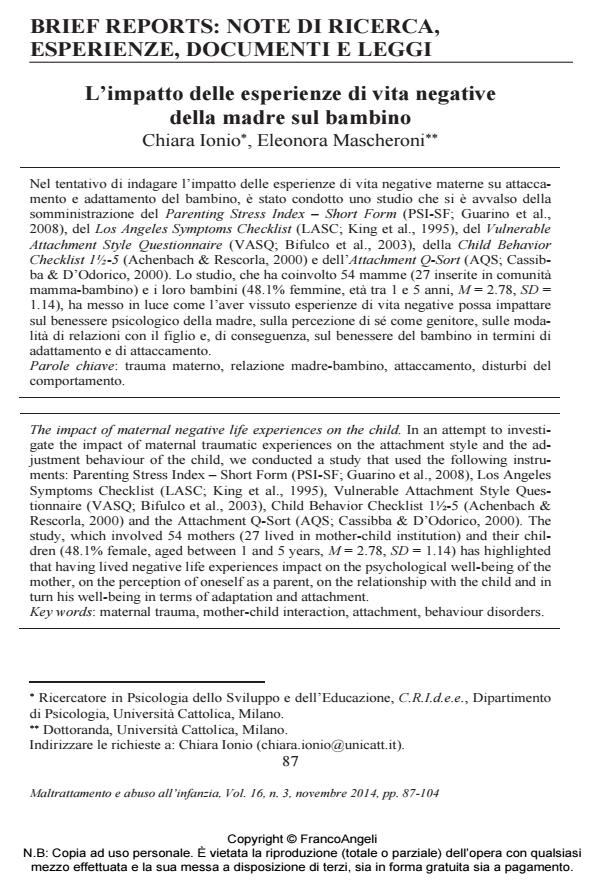L'impatto delle esperienze di vita negative della madre sul bambino
Titolo Rivista MALTRATTAMENTO E ABUSO ALL’INFANZIA
Autori/Curatori Chiara Ionio, Eleonora Mascheroni
Anno di pubblicazione 2014 Fascicolo 2014/3
Lingua Italiano Numero pagine 18 P. 87-104 Dimensione file 60 KB
DOI 10.3280/MAL2014-003006
Il DOI è il codice a barre della proprietà intellettuale: per saperne di più
clicca qui
Qui sotto puoi vedere in anteprima la prima pagina di questo articolo.
Se questo articolo ti interessa, lo puoi acquistare (e scaricare in formato pdf) seguendo le facili indicazioni per acquistare il download credit. Acquista Download Credits per scaricare questo Articolo in formato PDF

FrancoAngeli è membro della Publishers International Linking Association, Inc (PILA)associazione indipendente e non profit per facilitare (attraverso i servizi tecnologici implementati da CrossRef.org) l’accesso degli studiosi ai contenuti digitali nelle pubblicazioni professionali e scientifiche
Nel tentativo di indagare l’impatto delle esperienze di vita negative materne su attaccamento e adattamento del bambino, è stato condotto uno studio che si è avvalso della somministrazione del Parenting Stress Index - Short Form (PSI-SF; Guarino et al., 2008), del Los Angeles Symptoms Checklist (LASC; King et al., 1995), del Vulnerable Attachment Style Questionnaire (VASQ; Bifulco et al., 2003), della Child Behavior Checklist 1½-5 (Achenbach & Rescorla, 2000) e dell’Attachment Q-Sort (AQS; Cassibba & D’Odorico, 2000). Lo studio, che ha coinvolto 54 mamme (27 inserite in comunità mamma-bambino) e i loro bambini (48.1% femmine, età tra 1 e 5 anni, M = 2.78, SD = 1.14), ha messo in luce come l’aver vissuto esperienze di vita negative possa impattare sul benessere psicologico della madre, sulla percezione di sé come genitore, sulle modalità di relazioni con il figlio e, di conseguenza, sul benessere del bambino in termini di adattamento e di attaccamento.
Parole chiave:Trauma materno, relazione madre-bambino, attaccamento, disturbi del comportamento
- Mothers and fathers facing their children’s phenylketonuria Chiara Ionio, Elisabetta Salvatici, Emanuela Confalonieri, Luca Milani, Eleonora Mascheroni, Enrica Riva, Marcello Giovannini, in Children's Health Care /2018 pp.83
DOI: 10.1080/02739615.2016.1275643 - Risk assessment in a multicultural context: Risk and protective factors in the decision to place children in foster care Serena Grumi, Luca Milani, Paola Di Blasio, in Children and Youth Services Review /2017 pp.69
DOI: 10.1016/j.childyouth.2017.04.009 - La detenzione genitoriale: l'intervento psicoeducativo per il sostegno alle famiglie Marvita Goffredo, Isabella Berlingerio, Sonia Papagna, Maria Grazia Foschino Barbaro, in MALTRATTAMENTO E ABUSO ALL'INFANZIA 2/2017 pp.101
DOI: 10.3280/MAL2017-002006 - Essere genitori durante l'emergenza COVID-19: stress percepito e difficoltà emotive dei figli Elena Canzi, Laura Ferrari, Giulia Lopez, Francesca Vittoria Danioni, Sonia Ranieri, Miriam Parise, Ariela Francesca Pagani, Daniela Barni, Silvia Donato, Anna Bertoni, Giada Rapelli, Raffaella Iafrate, Margherita Lanz, Camillo Regalia, Rosa Rosnati, in MALTRATTAMENTO E ABUSO ALL'INFANZIA 1/2021 pp.29
DOI: 10.3280/MAL2021-001003 - Stile genitoriale autoritario, giustificazione della violenza e messa in atto di comportamenti di Dating Aggression Maria Giulia Olivari, Gaia Cuccì, Emanuela Confalonieri, in MALTRATTAMENTO E ABUSO ALL'INFANZIA 3/2017 pp.13
DOI: 10.3280/MAL2017-003002 - The Centrality of Events Scale for Italian adolescents: Integrating traumatic experience into one’s identity and its relation to posttraumatic stress disorder symptomatology Chiara Ionio, Eleonora Mascheroni, Paola Di Blasio, in Europe’s Journal of Psychology /2018 pp.359
DOI: 10.5964/ejop.v14i2.1465 - La valutazione della recuperabilità delle competenze genitoriali Michela Gardon, in MALTRATTAMENTO E ABUSO ALL'INFANZIA 1/2022 pp.87
DOI: 10.3280/MAL2022-001006 - Impact of maternal emotional experiences at birth and self-regulation in preterm children: The role of early interactions Chiara Ionio, Veronica Giannoni, Caterina Colombo, Giulia Ciuffo, Marta Landoni, Anna Banfi, Marina Balestriero, Barbara Scelsa, Gianluca Lista, in Journal of Neonatal Nursing /2023 pp.43
DOI: 10.1016/j.jnn.2022.01.012 - Premature birth: complexities and difficulties in building the mother–child relationship Chiara Ionio, Gianluca Lista, Eleonora Mascheroni, Maria Giulia Olivari, Emanuela Confalonieri, Massimo Mastrangelo, Valeria Brazzoduro, Maria Antonella Balestriero, Annamaria Banfi, Andrea Bonanomi, Stefania Bova, Francesca Castoldi, Caterina Colombo, Paola Introvini, Barbara Scelsa, in Journal of Reproductive and Infant Psychology /2017 pp.509
DOI: 10.1080/02646838.2017.1383977 - Parents' Psychological Factors Promoting Children's Mental Health and Emotional Regulation During the COVID-19 Lockdown Mara Morelli, Elena Cattelino, Roberto Baiocco, Emiddia Longobardi, Carmen Trumello, Alessandra Babore, Carla Candelori, Antonio Chirumbolo, in MALTRATTAMENTO E ABUSO ALL'INFANZIA 1/2021 pp.47
DOI: 10.3280/MAL2021-001004 - Padri maltrattanti coinvolti nella Tutela Minorile: un focus sui fattori di rischio e di protezione Serena Grumi, Eleonora Mascheroni, in MALTRATTAMENTO E ABUSO ALL'INFANZIA 3/2017 pp.111
DOI: 10.3280/MAL2017-003007 - Exploring differences in psychological aspects during pregnancy between cancer survivors and women without a history of cancer Eleonora Mascheroni, Flavia Faccio, Lucia Bonassi, Chiara Ionio, Fedro Alessandro Peccatori, Camilla Pisoni, Chiara Cassani, Giulia Ongaro, Elena Cattaneo, Giuseppe Nastasi, Gabriella Pravettoni, in Supportive Care in Cancer /2020 pp.2255
DOI: 10.1007/s00520-019-05048-w - The invisible legacy: What is the impact of ACEs on parenting and child development? Chiara Ionio, Giulia Ciuffo, Marta Landoni, in MALTRATTAMENTO E ABUSO ALL'INFANZIA 1/2025 pp.65
DOI: 10.3280/MAL2025-001004 - Children and Peace Luca Milani, Sarah Miragoli, Serena Grumi, Paola Di Blasio, pp.3 (ISBN:978-3-030-22175-1)
- The efficacy of interventions aimed at improving post-partum bonding: A review of interventions addressing parent-infant bonding in healthy and at risk populations Eleonora Mascheroni, Chiara Ionio, in Journal of Neonatal Nursing /2019 pp.61
DOI: 10.1016/j.jnn.2018.09.003 - IPV and prematurity: What does literature say? Chiara Ionio, Eleonora Mascheroni, Giulia Segre, in MALTRATTAMENTO E ABUSO ALL'INFANZIA 1/2020 pp.67
DOI: 10.3280/MAL2020-001006
Chiara Ionio, Eleonora Mascheroni, L'impatto delle esperienze di vita negative della madre sul bambino in "MALTRATTAMENTO E ABUSO ALL’INFANZIA" 3/2014, pp 87-104, DOI: 10.3280/MAL2014-003006